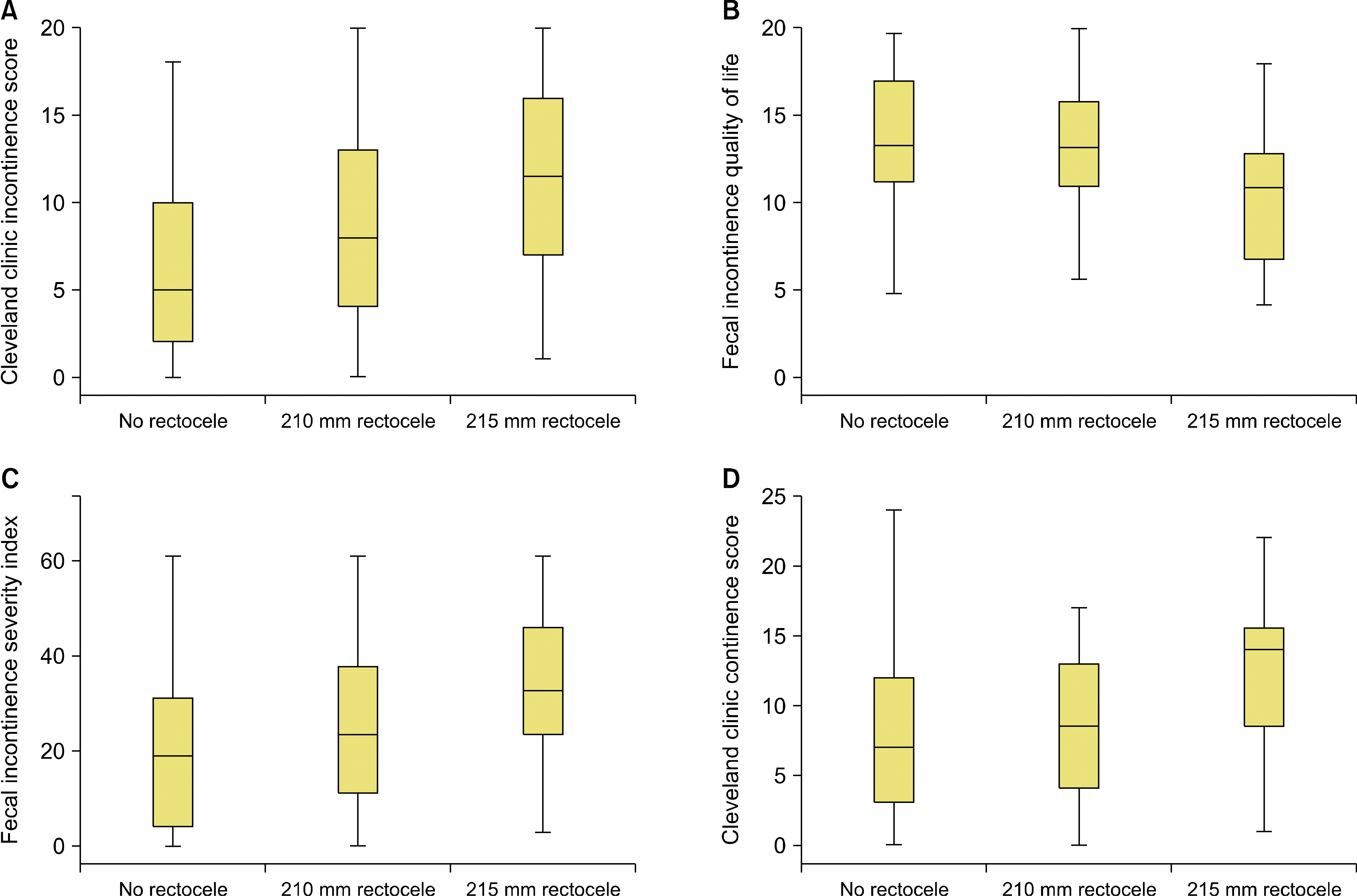1. Dietz HP, Beer-Gabel M. 2012; Ultrasound in the investigation of posterior compartment vaginal prolapse and obstructed defecation. Ultrasound Obstet Gynecol. 40:14–27. DOI:
10.1002/uog.10131. PMID:
22045564.

2. Porter WE, Steele A, Walsh P, Kohli N, Karram MM. 1999; The anatomic and functional outcomes of defect-specific rectocele repairs. Am J Obstet Gynecol. 181:1353–8. discussion 1358-9. DOI:
10.1016/S0002-9378(99)70376-5. PMID:
10601912.

4. Andromanakos N, Skandalakis P, Troupis T, Filippou D. 2006; Constipation of anorectal outlet obstruction: pathophysiology, evaluation and management. J Gastroenterol Hepatol. 21:638–46. DOI:
10.1111/j.1440-1746.2006.04333.x. PMID:
16677147.

5. Zbar AP, Lienemann A, Fritsch H, Beer-Gabel M, Pescatori M. 2003; Rectocele: pathogenesis and surgical management. Int J Colorectal Dis. 18:369–84. DOI:
10.1007/s00384-003-0478-z. PMID:
12665990.

7. Pitchford CA. 1967; Rectocele: a cause of anorectal pathologic changes in women. Dis Colon Rectum. 10:464–6. DOI:
10.1007/BF02616820. PMID:
6066371.
8. Bartolo DC, Roe AM, Virjee J, Mortensen NJ, Locke-Edmunds JC. 1988; An analysis of rectal morphology in obstructed defae-cation. Int J Colorectal Dis. 17–22. DOI:
10.1007/BF01649677. PMID:
3361219.

11. Harvey CJ, Halligan S, Bartram CI, Hollings N, Sahdev A, Kingston K. 1999; Evacuation proctography:a prospective study of diagnostic and therapeutic effects. Radiology. 211:223–7. DOI:
10.1148/radiology.211.1.r99mr16223. PMID:
10189475.

12. Beer-Gabel M, Carter D. 2015; Comparison of dynamic transperineal ultrasound and defecography for the evaluation of pelvic floor disorders. Int J Colorectal Dis. 30:835–41. DOI:
10.1007/s00384-015-2195-9. PMID:
25820786.

13. Perniola G, Shek C, Chong CC, Chew S, Cartmill J, Dietz HP. 2008; Defecation proctography and translabial ultrasound in the investigation of defecatory disorders. Ultrasound Obstet Gynecol. 31:567–71. DOI:
10.1002/uog.5337. PMID:
18409183.

14. Kenton K, Shott S, Brubaker L. 1999; The anatomic and functional variability of rectoceles in women. Int Urogynecol J Pelvic Floor Dysfunct. 10:96–9. DOI:
10.1007/PL00004019. PMID:
10384970.

15. Agachan F, Chen T, Pfeifer J, Reissman P, Wexner SD. 1996; A constipation scoring system to simplify evaluation and management of constipated patients. Dis Colon Rectum. 39:681–5. DOI:
10.1007/BF02056950. PMID:
8646957.

16. Rockwood TH, Church JM, Fleshman JW, Kane RL, Mavrantonis C, Thorson AG, et al. 2000; Fecal Incontinence Quality of Life Scale: quality of life instrument for patients with fecal incontinence. Dis Colon Rectum. 43:9–16. discussion 16-7. DOI:
10.1007/BF02237236. PMID:
10813117.
17. Shobeiri SA, LeClaire E, Nihira MA, Quiroz LH, O'Donoghue D. 2009; Appearance of the levator ani muscle subdivisions in endovaginal three-dimensional ultrasonography. Obstet Gynecol. 114:66–72. DOI:
10.1097/AOG.0b013e3181aa2c89. PMID:
19546760.

18. Morgan DM, Cardoza P, Guire K, Fenner DE, DeLancey JO. 2010; Levator ani defect status and lower urinary tract symptoms in women with pelvic organ prolapse. Int Urogynecol J. 21:47–52. DOI:
10.1007/s00192-009-0970-2. PMID:
19885634. PMCID:
PMC2866151.

19. Shobeiri SA, Rostaminia G, White D, Quiroz LH. 2013; The determinants of minimal levator hiatus and their relationship to the puborectalis muscle and the levator plate. BJOG. 120:205–11. Erratum in: BJOG 2013120:655. DOI:
10.1111/1471-0528.12055. PMID:
23157458.

20. Bordeianou LG, Carmichael JC, Paquette IM, Wexner S, Hull TL, Bernstein M, et al. 2018; Consensus statement of definitions for anorectal physiology testing and pelvic floor terminology (Revised). Dis Colon Rectum. 61:421–7. DOI:
10.1097/DCR.0000000000001070. PMID:
29521821.

22. Dietz HP, Steensma AB. 2005; Posterior compartment prolapse on two-dimensional and three-dimensional pelvic floor ultrasound: the distinction between true rectocele, perineal hypermobility and enterocele. Ultrasound Obstet Gynecol. 26:73–7. DOI:
10.1002/uog.1930. PMID:
15973648.

24. Dietz HP, Zhang X, Shek KL, Guzman RR. 2015; How large does a rectocele have to be to cause symptoms? A 3D/4D ultrasound study. Int Urogynecol J. 26:1355–9. DOI:
10.1007/s00192-015-2709-6. PMID:
25944658.

25. Guzman Rojas R, Kamisan Atan I, Shek KL, Dietz HP. 2016; The prevalence of abnormal posterior compartment anatomy and its association with obstructed defecation symptoms in urogynecological patients. Int Urogynecol J. 27:939–44. DOI:
10.1007/s00192-015-2914-3. PMID:
26670577.

26. Altman D, López A, Kierkegaard J, Zetterström J, Falconer C, Pollack J, et al. 2005; Assessment of posterior vaginal wall prolapse: comparison of physical findings to cystodefecoperitoneography. Int Urogynecol J Pelvic Floor Dysfunct. 16:96–103. discussion 103. DOI:
10.1007/s00192-004-1220-2. PMID:
15372142.

27. Turnbull GK, Bartram CI, Lennard-Jones JE. 1988; Radiologic studies of rectal evacuation in adults with idiopathic constipation. Dis Colon Rectum. 31:190–7. DOI:
10.1007/BF02552545. PMID:
3349875.

28. Yoshioka K, Matsui Y, Yamada O, Sakaguchi M, Takada H, Hioki K, et al. 1991; Physiologic and anatomic assessment of patients with rectocele. Dis Colon Rectum. 34:704–8. DOI:
10.1007/BF02050355. PMID:
1855428.

29. Kelvin FM, Maglinte DD, Hornback JA, Benson JT. 1992; Pelvic prolapse: assessment withevacuation proctography (defecography). Radiology. 184:547–51. DOI:
10.1148/radiology.184.2.1620863. PMID:
1620863.

30. Capps WF Jr. 1975; Rectoplasty and perineoplasty for the symptomatic rectocele: a report of fifty cases. Dis Colon Rectum. 18:237–43. DOI:
10.1007/BF02587281. PMID:
1140053.
31. Yang A, Mostwin JL, Rosenshein NB, Zerhouni EA. 1991; Pelvic floor descent in women: dynamic evaluation with fast MR imaging and cinematic display. Radiology. 179:25–33. DOI:
10.1148/radiology.179.1.2006286. PMID:
2006286.

32. Tan C, Geng J, Tang J, Yang X. 2020; The relationship between obstructed defecation and true rectocele in patients with pelvic organ prolapse. Sci Rep. 5599. DOI:
10.1038/s41598-020-62376-2. PMID:
32221359. PMCID:
PMC7101397.

33. Rotholtz NA, Efron JE, Weiss EG, Nogueras JJ, Wexner SD. 2002; Anal manometric predictors of significant rectocele in constipated patients. Tech Coloproctol. 6:73–6. discussion 76-7. DOI:
10.1007/s101510200016. PMID:
12402049.

35. Richardson AC. 1993; The rectovaginal septum revisited: its relationship to rectocele and its importance in rectocele repair. Clin Obstet Gynecol. 36:976–83. DOI:
10.1097/00003081-199312000-00022. PMID:
8293598.

36. Hendrix SL, Clark A, Nygaard I, Aragaki A, Barnabei V, McTiernan A. 2002; Pelvic organ prolapse in the Women's Health Initiative: gravity and gravidity. Am J Obstet Gynecol. 186:1160–6. DOI:
10.1067/mob.2002.123819. PMID:
12066091.







 PDF
PDF Citation
Citation Print
Print


 XML Download
XML Download